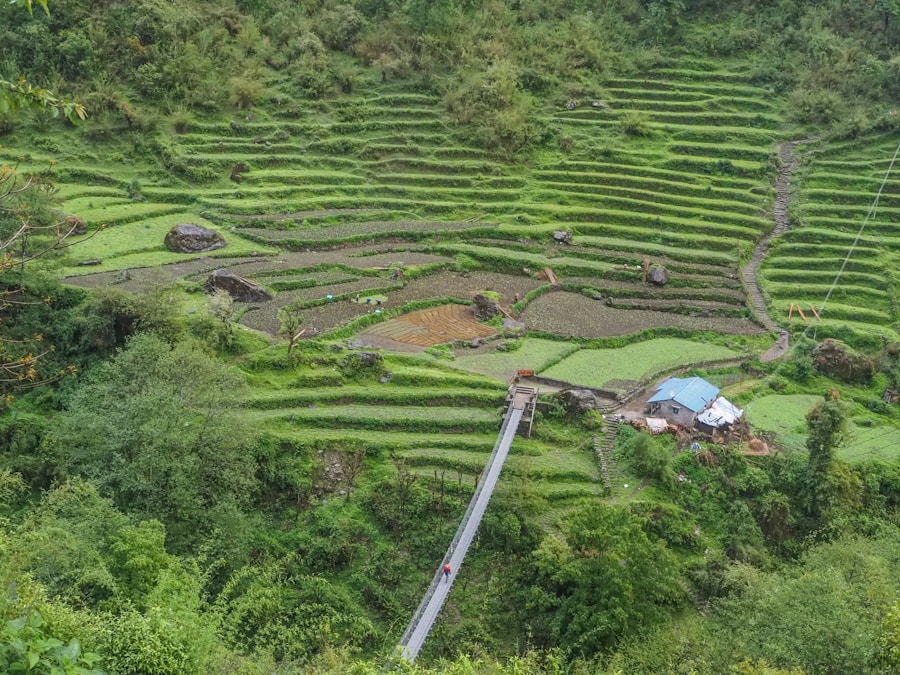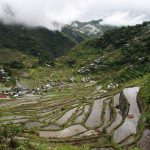Download links
How to install Banaue Rice Terraces: A Wonder of Ancient Engineering APK?
1. Tap the downloaded Banaue Rice Terraces: A Wonder of Ancient Engineering APK file.
2. Touch install.
3. Follow the steps on the screen.
Description
Nestled in the mountainous region of the Philippines, the Banaue Rice Terraces are often referred to as the “Eighth Wonder of the World.” This breathtaking landscape, carved into the mountainside over 2,000 years ago by the indigenous Ifugao people, showcases an extraordinary feat of agricultural engineering and cultural heritage. The terraces stretch over 2,000 square kilometers and rise to elevations of about 1,500 meters above sea level, creating a stunning visual tapestry of verdant green fields that cascade down the mountains. The rice terraces are not merely a testament to agricultural ingenuity; they are also a living cultural landscape that embodies the traditions, beliefs, and practices of the Ifugao community.
The significance of the Banaue Rice Terraces extends beyond their aesthetic appeal. They represent a harmonious relationship between humans and nature, demonstrating how traditional agricultural practices can coexist with the environment. The terraces are not just a means of food production; they are a symbol of identity and resilience for the Ifugao people.
As we delve deeper into the history, engineering marvels, challenges, and sustainability efforts surrounding these terraces, we uncover a rich narrative that highlights their importance in both local and global contexts.
Key Takeaways
- The Banaue Rice Terraces are an ancient agricultural wonder located in the Philippines, often referred to as the “Eighth Wonder of the World.”
- The terraces have been cultivated by the Ifugao people for over 2,000 years and are a symbol of their rich cultural heritage and sustainable farming practices.
- The engineering behind the terraces is a marvel, with the Ifugao people using stone and mud walls to create a complex irrigation system that allows for rice cultivation on steep mountain slopes.
- Despite their historical and cultural significance, the Banaue Rice Terraces face challenges such as soil erosion, population decline, and the impact of modernization on traditional farming practices.
- Tourism has brought both benefits and challenges to the Banaue Rice Terraces, providing economic opportunities for the local community while also contributing to environmental degradation and cultural commodification. Efforts are being made to balance tourism with the preservation of the terraces for future generations.
The History and Cultural Significance of the Banaue Rice Terraces
The origins of the Banaue Rice Terraces can be traced back to ancient times when the Ifugao people began cultivating rice in this mountainous region. According to oral traditions, the terraces were built by their ancestors as a response to the need for sustainable agriculture in a challenging environment.
This knowledge was passed down through generations, reflecting a profound connection to their land and heritage. Culturally, the rice terraces are intertwined with the Ifugao’s spiritual beliefs and practices. The Ifugao people hold rituals and ceremonies that honor their ancestors and the spirits of nature, which they believe play a crucial role in ensuring bountiful harvests.
The terraces are often seen as sacred spaces where these rituals take place, reinforcing their cultural significance. The Ifugao’s traditional practices, such as the “paddy rice planting” ceremony, highlight their respect for nature and their commitment to sustainable farming methods. This cultural heritage is not only vital for the identity of the Ifugao people but also serves as an important aspect of Philippine history.
The Engineering Marvel of the Banaue Rice Terraces

The engineering behind the Banaue Rice Terraces is nothing short of remarkable. Constructed without modern machinery, these terraces were built using simple tools and techniques that reflect an advanced understanding of agricultural engineering. The terraces are designed to maximize arable land while minimizing soil erosion, allowing rice cultivation in an otherwise steep and rugged terrain.
The intricate system of irrigation channels, which directs water from nearby rivers and streams to each terrace, showcases an impressive feat of hydraulic engineering. The terraces are built with a series of stone walls that retain water and soil, creating flat surfaces for planting rice. These walls are constructed using locally sourced materials, demonstrating a sustainable approach to building.
The design of the terraces also takes into account the natural contours of the land, allowing for efficient drainage and preventing waterlogging. This careful planning ensures that each terrace receives adequate sunlight and moisture, which are essential for rice cultivation. The engineering principles applied in constructing the Banaue Rice Terraces have garnered admiration from agricultural experts worldwide, who recognize them as an exemplary model of sustainable farming practices.
The Challenges and Sustainability of the Banaue Rice Terraces
| Challenges | Sustainability Efforts |
|---|---|
| Soil Erosion | Implementation of terrace maintenance and reforestation programs |
| Declining Number of Rice Farmers | Government support for young farmers and agricultural education programs |
| Tourism Impact | Development of sustainable tourism practices and community-based tourism initiatives |
| Climate Change | Adoption of climate-resilient farming techniques and water conservation measures |
| Traditional Farming Practices | Promotion of traditional knowledge and cultural preservation efforts |
Despite their historical significance and engineering brilliance, the Banaue Rice Terraces face numerous challenges that threaten their sustainability. One of the most pressing issues is climate change, which has led to unpredictable weather patterns affecting rainfall and temperature. These changes can disrupt traditional farming cycles and threaten crop yields, putting immense pressure on the Ifugao farmers who rely on these terraces for their livelihoods.
Additionally, natural disasters such as landslides and typhoons pose significant risks to the structural integrity of the terraces. Another challenge is the shift in agricultural practices among younger generations.
This trend threatens not only the rice terraces but also the cultural heritage associated with them. As fewer farmers tend to the terraces, issues such as overgrowth and neglect become more prevalent, further exacerbating the challenges faced by this UNESCO World Heritage site. Addressing these challenges requires a multifaceted approach that combines modern agricultural techniques with traditional knowledge to ensure the long-term sustainability of the rice terraces.
The Impact of Tourism on the Banaue Rice Terraces
Tourism has become a double-edged sword for the Banaue Rice Terraces. On one hand, it brings much-needed revenue to the local community and raises awareness about this cultural treasure on a global scale. Tourists flock to see the stunning landscapes and experience the rich culture of the Ifugao people, providing economic opportunities through hospitality services such as homestays, guided tours, and local crafts.
This influx of visitors can help fund conservation efforts and support local initiatives aimed at preserving both the terraces and their cultural significance. On the other hand, increased tourism can lead to environmental degradation and cultural commodification. The influx of visitors can strain local resources, leading to issues such as waste management problems and erosion of the terraces themselves.
Additionally, there is a risk that cultural practices may be altered or commercialized to cater to tourist expectations, potentially diluting their authenticity. Striking a balance between promoting tourism and preserving cultural integrity is crucial for ensuring that future generations can continue to appreciate both the beauty and significance of the Banaue Rice Terraces.
Preserving the Banaue Rice Terraces for Future Generations

Sustainable Agriculture and Cultural Heritage
Local government units, non-governmental organizations (NGOs), and community groups are collaborating to implement sustainable agricultural practices that honor traditional methods while integrating modern techniques. Educational programs aimed at younger generations emphasize the importance of maintaining their cultural heritage and encourage them to engage in farming activities within their communities.
Responsible Tourism and Economic Support
Initiatives focused on eco-tourism aim to promote responsible travel practices that benefit both visitors and locals. By encouraging tourists to engage with local culture authentically—such as participating in traditional farming activities or attending cultural festivals—these initiatives help foster a deeper appreciation for the terraces’ significance while providing economic support to local families.
Conservation and Restoration
Additionally, conservation projects aimed at restoring neglected terraces are being implemented to ensure that these historical structures remain intact for years to come.
In conclusion, preserving the Banaue Rice Terraces is not merely about maintaining an agricultural landscape; it is about safeguarding a way of life that embodies resilience, sustainability, and cultural identity. Through collaborative efforts that respect both tradition and innovation, there is hope that this extraordinary heritage will continue to thrive for generations to come.
If you are interested in exploring more about the culture and traditions of the Philippines, you may want to check out an article on how to win exciting prizes in the Freefire lottery. The article titled “Raih Hadiah Menarik di Freefire Lottery” provides tips and tricks on how to get free rewards in the popular game. You can read more about it here.
FAQs
What are the Banaue Rice Terraces?
The Banaue Rice Terraces are ancient terraces carved into the mountains of Ifugao in the Philippines. They are often referred to as the “Eighth Wonder of the World” and are a UNESCO World Heritage Site.
How were the Banaue Rice Terraces created?
The terraces were hand-carved over 2,000 years ago by the Ifugao people using minimal tools. They were created to make the mountainous terrain suitable for rice cultivation.
What is the significance of the Banaue Rice Terraces?
The terraces are not only a stunning example of ancient engineering, but they also represent the sustainable farming practices of the Ifugao people. They are a symbol of Filipino heritage and culture.
Can visitors explore the Banaue Rice Terraces?
Yes, visitors can explore the terraces and even hike through them. There are also local guides available to provide tours and information about the history and significance of the terraces.
What is the best time to visit the Banaue Rice Terraces?
The best time to visit is during the planting season, which is typically between April and May, or during the harvest season, which is between August and September. However, the terraces are beautiful to visit year-round.





